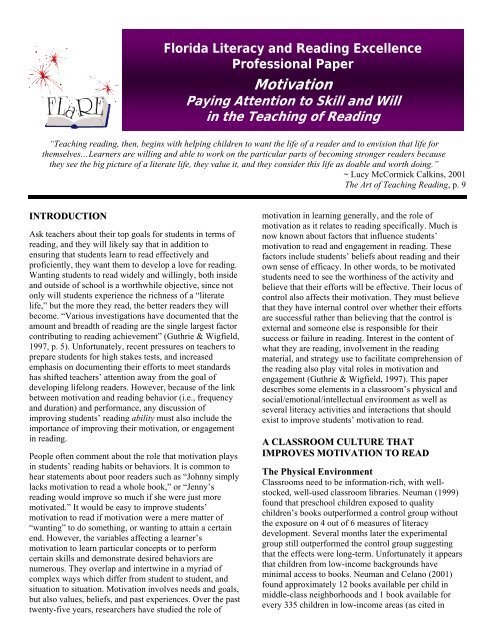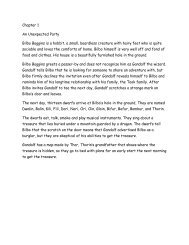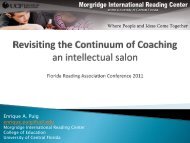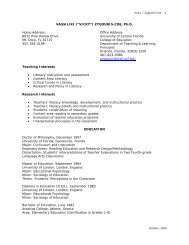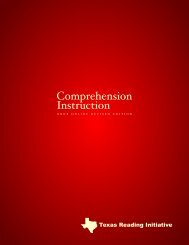FLaRE Professional Paper: Motivation - College of Education ...
FLaRE Professional Paper: Motivation - College of Education ...
FLaRE Professional Paper: Motivation - College of Education ...
Create successful ePaper yourself
Turn your PDF publications into a flip-book with our unique Google optimized e-Paper software.
Florida Literacy and Reading Excellence<br />
<strong>Pr<strong>of</strong>essional</strong> <strong>Paper</strong><br />
<strong>Motivation</strong><br />
Paying Attention to Skill and Will<br />
in the Teaching <strong>of</strong> Reading<br />
“Teaching reading, then, begins with helping children to want the life <strong>of</strong> a reader and to envision that life for<br />
themselves…Learners are willing and able to work on the particular parts <strong>of</strong> becoming stronger readers because<br />
they see the big picture <strong>of</strong> a literate life, they value it, and they consider this life as doable and worth doing.”<br />
~ Lucy McCormick Calkins, 2001<br />
The Art <strong>of</strong> Teaching Reading, p. 9<br />
INTRODUCTION<br />
Ask teachers about their top goals for students in terms <strong>of</strong><br />
reading, and they will likely say that in addition to<br />
ensuring that students learn to read effectively and<br />
pr<strong>of</strong>iciently, they want them to develop a love for reading.<br />
Wanting students to read widely and willingly, both inside<br />
and outside <strong>of</strong> school is a worthwhile objective, since not<br />
only will students experience the richness <strong>of</strong> a “literate<br />
life,” but the more they read, the better readers they will<br />
become. “Various investigations have documented that the<br />
amount and breadth <strong>of</strong> reading are the single largest factor<br />
contributing to reading achievement” (Guthrie & Wigfield,<br />
1997, p. 5). Unfortunately, recent pressures on teachers to<br />
prepare students for high stakes tests, and increased<br />
emphasis on documenting their efforts to meet standards<br />
has shifted teachers’ attention away from the goal <strong>of</strong><br />
developing lifelong readers. However, because <strong>of</strong> the link<br />
between motivation and reading behavior (i.e., frequency<br />
and duration) and performance, any discussion <strong>of</strong><br />
improving students’ reading ability must also include the<br />
importance <strong>of</strong> improving their motivation, or engagement<br />
in reading.<br />
People <strong>of</strong>ten comment about the role that motivation plays<br />
in students’ reading habits or behaviors. It is common to<br />
hear statements about poor readers such as “Johnny simply<br />
lacks motivation to read a whole book,” or “Jenny’s<br />
reading would improve so much if she were just more<br />
motivated.” It would be easy to improve students’<br />
motivation to read if motivation were a mere matter <strong>of</strong><br />
“wanting” to do something, or wanting to attain a certain<br />
end. However, the variables affecting a learner’s<br />
motivation to learn particular concepts or to perform<br />
certain skills and demonstrate desired behaviors are<br />
numerous. They overlap and intertwine in a myriad <strong>of</strong><br />
complex ways which differ from student to student, and<br />
situation to situation. <strong>Motivation</strong> involves needs and goals,<br />
but also values, beliefs, and past experiences. Over the past<br />
twenty-five years, researchers have studied the role <strong>of</strong><br />
motivation in learning generally, and the role <strong>of</strong><br />
motivation as it relates to reading specifically. Much is<br />
now known about factors that influence students’<br />
motivation to read and engagement in reading. These<br />
factors include students’ beliefs about reading and their<br />
own sense <strong>of</strong> efficacy. In other words, to be motivated<br />
students need to see the worthiness <strong>of</strong> the activity and<br />
believe that their efforts will be effective. Their locus <strong>of</strong><br />
control also affects their motivation. They must believe<br />
that they have internal control over whether their efforts<br />
are successful rather than believing that the control is<br />
external and someone else is responsible for their<br />
success or failure in reading. Interest in the content <strong>of</strong><br />
what they are reading, involvement in the reading<br />
material, and strategy use to facilitate comprehension <strong>of</strong><br />
the reading also play vital roles in motivation and<br />
engagement (Guthrie & Wigfield, 1997). This paper<br />
describes some elements in a classroom’s physical and<br />
social/emotional/intellectual environment as well as<br />
several literacy activities and interactions that should<br />
exist to improve students’ motivation to read.<br />
A CLASSROOM CULTURE THAT<br />
IMPROVES MOTIVATION TO READ<br />
The Physical Environment<br />
Classrooms need to be information-rich, with wellstocked,<br />
well-used classroom libraries. Neuman (1999)<br />
found that preschool children exposed to quality<br />
children’s books outperformed a control group without<br />
the exposure on 4 out <strong>of</strong> 6 measures <strong>of</strong> literacy<br />
development. Several months later the experimental<br />
group still outperformed the control group suggesting<br />
that the effects were long-term. Unfortunately it appears<br />
that children from low-income backgrounds have<br />
minimal access to books. Neuman and Celano (2001)<br />
found approximately 12 books available per child in<br />
middle-class neighborhoods and 1 book available for<br />
every 335 children in low-income areas (as cited in
Neuman & Celano, 2004). Several studies have reported<br />
that many students retrieve books for independent reading<br />
from the school or classroom library (Fleener, Morrison,<br />
Linek, & Rasinski, 1997; Krashen, 1993; Lamme, 1976;<br />
Worthy, Moorman, & Turner, 1999). Perhaps those<br />
students benefiting the most from retrieving books from<br />
classroom and school libraries are those who have little or<br />
no access to books. In spite <strong>of</strong> this research, funding for<br />
classroom, school, and town libraries has seriously<br />
declined over the past decade. According to a recent<br />
position statement by the International Reading<br />
Association, “We must reverse this trend because children<br />
who have access to books are more likely to read for<br />
enjoyment, and thus increase their reading skills and their<br />
desire to read to learn” (IRA, 2000, p.1). Educators need to<br />
also pay attention to the types <strong>of</strong> reading materials in the<br />
classroom library, ensuring that the materials not only<br />
address a range <strong>of</strong> reading levels and interests, but that<br />
they appeal to both boys and girls. According to Knowles<br />
and Smith (2005), “Classroom libraries, librarians,<br />
summer reading, and required course reading lists do not<br />
reflect the kinds <strong>of</strong> books that boys enjoy most” (p. xi)<br />
which tend to be factual, humorous, with lots <strong>of</strong> visual<br />
stimulation and support for the text. Including a wide<br />
variety <strong>of</strong> types <strong>of</strong> texts, from newspapers and trade<br />
paperbacks to “classics” to comic books is essential.<br />
Allowing students frequent access to these materials and<br />
giving them the opportunity to take these materials home<br />
is essential, as many students are not able to borrow books<br />
from the public library, for a variety <strong>of</strong> reasons.<br />
The Social/Emotional/Intellectual Environment<br />
In addition to having access to texts in the classroom,<br />
students at all grade levels need time to read, both in and<br />
outside <strong>of</strong> school. Practice makes perfect, as the popular<br />
proverb reminds us. Allington (2001) stated that the act <strong>of</strong><br />
reading is powerful in developing readers who read with<br />
accuracy, fluency, and comprehension. Anderson, Wilson,<br />
and Fielding (1988) found that students who did not read<br />
during their free time outside <strong>of</strong> school ultimately lost<br />
academic ground, even those who were not originally<br />
labeled as remedial readers. Furthermore, the National<br />
Assessment <strong>of</strong> <strong>Education</strong>al Progress (NAEP) discovered<br />
hundreds <strong>of</strong> correlational studies which revealed<br />
successful readers simply read more in and out <strong>of</strong> school<br />
(Donahue, Finnegan, Lutkus, Allen, & Campbell, 2001).<br />
In commenting about the “remarkably consistent” link<br />
between free reading and literacy development, Krashen<br />
(1993) noted that “Nearly every study that has examined<br />
this relationship has found a correlation, and it is present<br />
even when different tests, different methods <strong>of</strong> probing<br />
reading habits, and different definitions <strong>of</strong> free reading are<br />
used” (p. 7). Time to read must be allocated in the daily<br />
classroom schedule to show that it is a valued activity and<br />
to give students a chance that they might not take outside<br />
<strong>of</strong> school to discover books that they enjoy.<br />
Students need to be allowed to make choices about some<br />
<strong>of</strong> the materials that they read, especially for independent<br />
(free) reading, and for literature discussion groups. Choice<br />
about what books to read, and how to demonstrate an<br />
understanding <strong>of</strong> the book is critically important. Teachers<br />
must resist the temptation to control students’ choices. For<br />
example, the growing practice <strong>of</strong> allowing students to<br />
borrow from the library and read only certain levels or<br />
types <strong>of</strong> books (i.e., a book that they can take a<br />
computerized test on) is a dangerous one and likely to<br />
mitigate against motivation to read. At the same time,<br />
teachers need to help students learn to make good choices,<br />
by teaching them how to select a book that they can read<br />
successfully (e.g., Ohlhausen & Jepsen, 1992; Routman,<br />
2003). Teachers need to know their individual learners’<br />
interests and hobbies, and know the field <strong>of</strong> children’s<br />
literature so that they can help to match students with<br />
books that will be interesting and satisfying.<br />
Teachers need to model, through daily interactive read<br />
alouds the value <strong>of</strong> reading. In order to influence<br />
students’ own reading, Routman (2003) advocates for<br />
teachers to make their “reading lives explicit” (p. 25).<br />
She encourages teachers to (pp. 23-37):<br />
• Let students know what you are reading and<br />
what you read next;<br />
• Share your passion for reading;<br />
• Discuss the importance and pleasure <strong>of</strong> having a<br />
personal library;<br />
• Talk about favorite authors and favorite books;<br />
• Talk about how book clubs work;<br />
• Explain how you choose books to read;<br />
• Read a variety <strong>of</strong> genres;<br />
• Maintain a reading record;<br />
• Show your students how you read; and<br />
• Demonstrate your pleasure in reading.<br />
Students need opportunities to interact with peers, to<br />
communicate about books and their responses to books<br />
and the chance to collaborate with them on assignments.<br />
Cole conducted a study in an attempt to understand what<br />
motivated several second-graders to read (2002/2003).<br />
She found each student was motivated to read for<br />
different reasons and obtained a unique literacy<br />
personality. Most <strong>of</strong> the students in her study were<br />
motivated to read due to one or more social components<br />
<strong>of</strong> the classroom such as class discussions and acting out<br />
stories with peers. As a result <strong>of</strong> her findings, Cole<br />
suggested that teachers provide flexible literacy<br />
activities including those that allow for social<br />
interactions. Cole stated, “While some students learn<br />
efficiently on their own, many children need the support<br />
<strong>of</strong> peers and talk to learn and achieve” (p. 335). In<br />
addition, creating opportunities for productive social<br />
interactions increases students’ effort and persistence,
which in turn increases students’ sense <strong>of</strong> efficacy,<br />
competence, and locus <strong>of</strong> control (Turner & Paris, 1995).<br />
The notion <strong>of</strong> a community <strong>of</strong> readers was documented by<br />
Hepler and Hickman (1982) after observing the influence<br />
<strong>of</strong> social interaction on students’ reading. They reported<br />
that student’s actions with and words about books were<br />
influenced by others. Incidental talk such as “’Have you<br />
read this?’ or ‘Listen to this!’” (p. 280) appeared to<br />
motivate students to read books after hearing about the<br />
plot and knowing that at least one peer liked the book.<br />
Other researchers have additionally reported that the most<br />
avid readers are those who talk with their peers about<br />
books, share writing, and discuss homework with others<br />
(Guthrie & Anderson, 1999).<br />
The Literacy Activities and Interactions that<br />
Take Place<br />
The kinds <strong>of</strong> activities and interactions around text that<br />
teachers design can have tremendous impact on students’<br />
motivation to read. Learning tasks need to be authentic and<br />
perceived by students to be meaningful and relevant. They<br />
should be sufficiently challenging, neither too easy nor too<br />
difficult. Whenever possible, teachers should design<br />
“open” rather than “closed” tasks. In a study <strong>of</strong> first grade<br />
classrooms, Turner and Paris (1995) found that teachers<br />
who designed “open tasks” were most successful in<br />
motivating children to read and write. Open tasks were<br />
those with more than one correct answer, and more than<br />
one possible procedure to follow to complete. “Open tasks<br />
required students to set goals, select and organize<br />
information, choose strategies, and assess the final results”<br />
(p.664).<br />
In a study conducted by Marinak (2004) literacy related<br />
rewards (books) did not appear to undermine intrinsic<br />
motivation to read, but token rewards that were not related<br />
to literacy (e.g., key chain, bracelets) undermined intrinsic<br />
motivation. This study supports the hypothesis posed by<br />
Gambrell (1996) that the extrinsic reward that is closer in<br />
proximity to the desired behavior is more likely to support<br />
intrinsic motivation.<br />
School activities must be implemented that foster intrinsic<br />
motivation and allow students to discuss enjoyable books<br />
and join in a classroom or school wide reading community.<br />
The following are suggestions <strong>of</strong> activities to implement:<br />
• Literature discussion groups – small groups <strong>of</strong><br />
students choose a common book to read and<br />
engage in natural, open discussions with one<br />
another about their reading (Daniels, 2002)<br />
• Idea circles – three to six students share a<br />
concept to research using multiple texts and<br />
formulate an evolving consensus about the<br />
concept (Guthrie & McCann, 1996)<br />
• E-mail – classes at different schools send emails<br />
about suggested books<br />
• Interactive read alouds and open-ended<br />
discussions – reading aloud to students at any<br />
age has many benefits, including fostering<br />
students’ interest in books (Miller, 2002;<br />
Rasinski, 2003); teachers facilitate discussions<br />
relating to the read aloud with open-ended<br />
statements or questions<br />
• Book talks – students briefly describe a book<br />
and explain why they liked it to a large or small<br />
group<br />
• Newsletter – classroom newsletter includes a<br />
column written by students about “good books”<br />
CONCLUSION<br />
There’s no doubt that the act <strong>of</strong> reading fosters better<br />
readers. “The last twenty-five years <strong>of</strong> reading research<br />
confirms this simple formula—regardless <strong>of</strong> sex, race,<br />
nationality or socioeconomic background. Students who<br />
read the most, read the best, achieve the most, and stay<br />
in school the longest. Conversely, those who don’t read<br />
much, cannot get better at it” (Trelease, 2001, p. 7).<br />
Educators must create a classroom culture that facilitates<br />
motivation to read and implement literacy activities and<br />
interactions that cause an increase in students’<br />
motivation so that not only will students have the skill to<br />
read but the lifelong desire for the will to read.<br />
REFERENCES<br />
Allington, R. (2001). What really matters for struggling readers: Designing research based programs. New York:<br />
Addison-Wesley <strong>Education</strong>al Publishers Inc.<br />
Anderson, R., Wilson, P., & Fielding, L. (1988). Growth in reading and how children spend their time outside <strong>of</strong> school.<br />
Reading Research Quarterly, 23, 285-303.<br />
Calkins, L. M. (2001). The art <strong>of</strong> teaching reading. New York: Longman.<br />
Coles, J. (2002/2003). What motivates students to read? Four literacy personalities. The Reading Teacher, 56(4), 326-336.<br />
Donahue, P., Finnegan, R., Lutkus, A., Allen, N., & Campbell, J. (2001). The nation’s report card: Fourth-grade 2000.<br />
National Center for <strong>Education</strong> Statistics. Available Online at http://nces.ed.gov/pubsearch/pubsinfo.asp?pubid=<br />
2001499.
Fleener, C., Morrison, S., Linek, W., & Rasinski, T. (1997). Recreational reading choices: How do children select books?<br />
In W. M. Linek & E. G. Sturtevant (Eds.), Exploring literacy (pp. 75-84). Platteville, WI: <strong>College</strong> Reading<br />
Association.<br />
Gambrell, L. (2000). Creating classroom cultures that foster reading motivation. In N. Padack, T. Rasinski, et al (Eds.).<br />
Distinguished Educators on Reading: Contributions that have shaped effective literacy instruction. Newark, DE:<br />
International Reading Association.<br />
Gambrell, L. (1996). Creating classrooms cultures that foster reading motivation. The Reading Teacher, 50, 4-25.<br />
Guthrie, J., & Anderson, E. (1999). Engagement in reading: Processes <strong>of</strong> motivated, strategic, knowledgeable, social<br />
readers. In J. T. Guthrie & D. E. Alvermann (Eds.), Engaged reading: Processes, practices, and policy implications<br />
(pp. 17-45). New York: Teachers <strong>College</strong> Press.<br />
Guthrie, J., & Wigfield, A. (2000). Engagement and motivation in reading. In M. Kamil, P. Mosenthal, P. D. Pearson, &<br />
R. Barr (Eds.). Handbook <strong>of</strong> Reading Research, Volume 3. Mahwah, NJ: Lawrence Erlbaum Associates, Publishers.<br />
Guthrie, J., & Wigfield, A. (1997). Reading Engagement: Motivating readers through integrated instruction. Newark,<br />
DE: International Reading Association.<br />
Helper, S., & Hickman, J. (1982). “The book was okay. I love you” – Social aspects <strong>of</strong> response to literature. Theory Into<br />
Practice, 21(4), 278-283.<br />
Knowles, E., & Smith, M. (2005). Boys and literacy: Practical strategies for librarians, teachers, and parents. Westport,<br />
CT: Libraries Unlimited.<br />
Krashen, S. (1993). The power <strong>of</strong> reading: Insights from the research. Englewood, CO: Libraries Unlimited, Inc.<br />
Marinak, B. (2004) The effects <strong>of</strong> reward proximity and choice <strong>of</strong> reward on the reading motivation <strong>of</strong> third-grade<br />
students. Available Online at https://drum.umd.edu/dspace/bitstream/1903/1969/1/umi-umd-1920.pdf.<br />
Neuman, S., & Celano, D. (2004). Save the libraries! <strong>Education</strong>al Leadership, 61(6), 82-85.<br />
Neuman, S.B. (1999). Books make a difference: A study <strong>of</strong> access to literacy. Reading Research Quarterly, 34(3), 286–<br />
311.<br />
Ohlhausen, M., & Jepsen, M. (1992). Lessons from Goldilocks: “Somebody’s been choosing my books but I can make my<br />
own choices now.” The New Advocate, 5, 31-46.<br />
Reynolds, M. (2004). I won’t read and you can’t make me: Reaching reluctant teen readers. Portsmouth, NH:<br />
Heinemann.<br />
Routman, R. (2003). Reading essentials: The specifics you need to teach reading well. Portsmouth, NH: Heinemann.<br />
Trelease, J. (2001). The Read-aloud handbook. NY: Penguin.<br />
Turner, J., & Paris, S. (1995). How literacy tasks influence children’s motivation for literacy. The Reading Teacher, 18(8),<br />
662-672.<br />
Worthy, J., Moorman, M., & Turner, M. (1999). What Johnny likes to read is hard to find in schools. Reading Research<br />
Quarterly, 34(1), 12-27.<br />
This <strong>FLaRE</strong> <strong>Pr<strong>of</strong>essional</strong> <strong>Paper</strong> was developed (June, 2006) by the following <strong>FLaRE</strong> Faculty Fellows (in alphabetical order):<br />
Deborah Harris, PhD, Florida Atlantic University<br />
Wanda Hedrick, PhD, University <strong>of</strong> North Florida<br />
Lunetta Williams, PhD, University <strong>of</strong> North Florida<br />
Nancy Williams, PhD, University <strong>of</strong> South Florida<br />
<strong>FLaRE</strong> Center<br />
Teaching Academy – Suite 403<br />
University <strong>of</strong> Central Florida<br />
4000 Central Florida Blvd<br />
Orlando, FL 32816-1250<br />
Phone: 407-823-4785<br />
FAX: 407-823-4682<br />
http://flare.ucf.edu<br />
<strong>FLaRE</strong> is a Project <strong>of</strong> the University <strong>of</strong> Central Florida <strong>College</strong> <strong>of</strong> <strong>Education</strong> and<br />
administered under a grant from the Florida Department <strong>of</strong> <strong>Education</strong> and Just Read, Florida!


